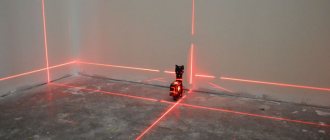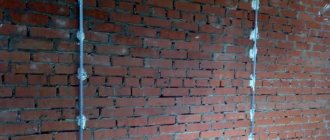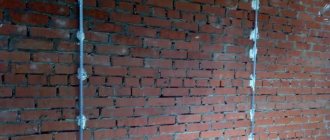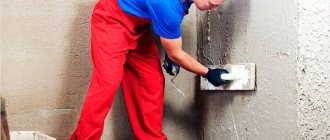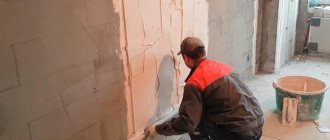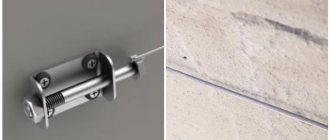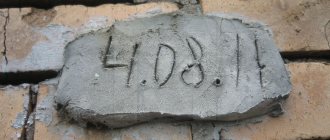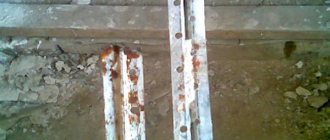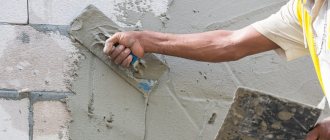Any building structure requires the next stage of work - finishing. The most common option for protecting and giving smooth geometry to walls and ceilings is plaster. The material is produced in a wide range for different substrates and conditions of use, but not a single mixture is capable of creating an ideal surface without the use of additional equipment and tools. With the help of profile structures, you can simplify the alignment process and provide the walls and flows with the desired geometry, which will subsequently become the basis for decorative finishing.
What is a plaster beacon
A plaster beacon is a special device that simplifies the work of leveling bases and provides a flat surface. Beacons for plastering walls can be made of metal, plastic and wood, and there are also different options for homemade devices that create a restrictive barrier during alignment.
The design consists of a U-shaped corner or V-shaped profile with perforation and even a round section in the form of a pipe. Holes in the elements make it possible to secure them to the surface. Hardware can be different - these are dowels for walls made of concrete or brick and self-tapping screws for wooden and block structures. The technology for installing guides consists of a variety of fasteners: the more of them, the more accurate the alignment will be.
Corner beacons are used to construct corners; V-shaped profiles create optimal conditions for constructing a coating.
On a note!
When performing work, disposable profiles are used, which are dismantled when the solution sets and used again.
The most effective means for making walls even are beacons for plaster.
Basic requirements for gypsum beacons
Dimensions of gypsum beacons
The shape of a gypsum beacon can be very different - from a rectangular plate to a figure eight.
Summarizing information from sources, we can say that the following dimensions are acceptable:
- length - 150-250 mm
- width - 40-70 mm
- thickness - 6-15 mm
In this case, the plan configuration can be in the form of a rectangular plate, a figure eight, or intermediate figures between these two. Overall dimensions should have an aspect ratio of approximately 1:3 to 1:5. The thickness can range from 6 to 15 mm, but it is indicated that the thickness where the crack passes under the lighthouse should be the smallest.
Why do the sources give such a variation in the sizes of gypsum beacons and can their sizes differ from those indicated in practice? To answer this question, you should refer to the conditions for using beacons and the features of the structures on which they are installed. Firstly, the size of the crack opening is important - the wider the crack, the longer the beacon. But with a large crack opening, the cross-section of the beacon should also be large enough, because in the place where the beacon passes over the crack, as we remember, its thickness is assumed to be minimal. Accordingly, the largest sizes of beacons are used when the crack opening is large. Typically, this picture can be observed in brick buildings that have damage in the form of extended single cracks from uneven settlement of foundations and foundation soils. On the contrary, in reinforced concrete structures, cracks most often have slight openings and beacons for them are made of smaller sizes. Although, for reinforced concrete structures the use of gypsum beacons is not recommended. In any case, the area of connection between the lighthouse and the surface of the structure depends on the width and length of the beacon. To assess the necessary geometric parameters of a gypsum beacon in each specific case, you should remember the main rule:
Such beacons are more likely to come off the surface of the structure than to crack
Gypsum lighthouse peeling off from the base
Those. when a crack opens, the beacon should rupture above the crack, and not tear off from the surface of the structure. And at the same time, if the crack is stable, the lighthouse should remain intact. Too large a cross-section of a gypsum beacon (this usually happens when its thickness exceeds 15 mm) leads to separation of the beacon from the structure on one side of the crack, while the beacon itself remains intact. The same picture can be observed in cases where, when installing the beacon, its high-quality fastening to the structure was not ensured. This may occur due to the small size of the contact area between the beacon and the structure, or poor preparation of the surface of the structure before installing the beacon. Those. When determining the required dimensions of a lighthouse, the surface of the structure is also important - how smooth, dusty, absorbent, etc. it is. The worse the adhesion to the surface, the larger the area of contact between the beacon and the structure should be.
Speaking about the geometry of gypsum beacons, one cannot help but say that the small thickness of the beacon is unacceptable. When the beacon thickness is less than 5 mm, even minor temperature and vibration influences lead to the formation of a crack. Those. in fact, the beacon “triggers” without significant changes in the crack opening width.
Material for gypsum beacons
Lighthouse in the form of a glued plaster plate
Most often, lighthouses are made of building gypsum (alabaster). This material is susceptible to moisture, and therefore its use for the manufacture of beacons in damp rooms and outdoors (especially in the basement area of buildings) is not recommended. Mortar beacons are more stable in such places - they are made from cement-sand mortar. Their disadvantages include poor adhesion to the surface of structures. Currently, more suitable materials have become widespread - dry building mixtures. It is preferable to use gypsum and cement plaster, as well as adhesive mixtures. In addition, there are beacons in the form of gypsum plates mounted on glue, prepared in advance. Such blanks can be made from gypsum in molds, or cut from sheet gypsum materials. When using ready-made gypsum beacons, it is important to ensure their reliable adhesive attachment to the surface of the structure. The advantages of gypsum blanks for beacons include the ability to make beacons of any shape and dimensional stability.
Purpose
The main function of the lighthouse structure is to level the mixture along the guides, but profiles are often used to perform other finishing work.
Purpose and use of beacons:
- creating the top border of a layer or fill;
- guides for leveling ceramic and stone tiles;
- reinforcing function when the structure remains inside the coating.
For all applications, profiles made of different materials can be used. Galvanized metal, aluminum and plastic can be used both one-time and to create additional reinforcement of the coating, and reusable when elements are dismantled. It is not recommended to leave metal beacons inside unless they are intended for that purpose. During the operation of buildings, the coating can accumulate moisture, which will lead to corrosion and peeling of the finishing layer from the base.
Most often, beacons are installed along the entire length of walls requiring plastering.
Methodological literature
The literature describing the requirements and methods for using gypsum (alabaster / cement) beacons relates to different areas. The corresponding descriptions are in the documents intended for:
It is recommended to install at least two gypsum beacons per crack
- services for the operation of buildings and structures for various purposes
- specialists in technical supervision and control of construction processes
- experts and technical survey specialists
- specialists performing geotechnical monitoring and observation of deformations of foundations of buildings and structures
- and etc.
We have made a selection from the texts of these sources and below we post quotes only from some of the documents that best reveal the features of lighthouses of this type. It so happened that the selected documents are mainly intended for specialists in technical inspection and monitoring of buildings and structures.
[/toggles]
The above quotes contain a lot of information we need on the use of gypsum beacons, but still the picture will be incomplete if we do not take into account the practice of using gypsum beacons. Accordingly, we will analyze these and other documents taking into account the existing practice of using gypsum beacons and, based on such analysis, we will formulate the basic requirements for these devices.
Sizes and shapes of beacons for plaster
Choosing the right product in the store is not difficult. Retail outlets offer an assortment of all types of elements, but before purchasing you need to know the surface area and the number of guides needed.
The height of the profiles is 3-30 mm, which determines the thickness of the coating; the length for purchased guides does not exceed 3 m, but this size is quite enough to carry out work in most modern houses. There are non-standard lengths that reach 6 m, but such profiles are difficult to transport, so they are not sold in all stores.
Attention!
The size of the beacon base for perforated plaster can vary between 20-50 mm. The diameter of the holes is different in any type of structural element, which allows you to use any fastening element for installation.
How to choose beacons
Before making a purchase, you need to estimate the curvature and know the surface area. The cost of the products is low, but the approximate quantity must be determined before going to the store. The disadvantage entails additional travel costs or violation of installation technology while saving guides, which as a result may affect the quality of the coating.
Rules for selecting elements:
- the profile height is determined by the largest surface curvature;
- a product length of 6 m is more often used when finishing facades; for applying the solution indoors, a standard size of 2.7-3.0 m is sufficient;
- when choosing, you need to pay attention to the shape, which should not be deformed, otherwise it will be difficult to achieve a flat surface during application;
- if you plan to leave the guides in the solution layer, then the quality of the anti-corrosion coating should not cause concern;
- at the slightest violation of the galvanized layer, you should refuse to purchase or choose a more expensive option for aluminum products that are not susceptible to rust.
The number of required products is determined based on the markings with the addition of 10-15% to the total figure, which may be needed in case of fracture or deformation of profiles associated with delivery, unloading and installation.
There are guides of various sizes on sale - from 3 mm to 3 cm
Features of using gypsum beacons
Temperature influences
Such a “plaster blot” can hardly be called a beacon.
If it is of significant length, a crack located, for example, in a boundary wall, acts as an expansion joint, changing the width of the opening depending on temperature changes. If a gypsum beacon is installed on such a crack, then it always “triggers”, regardless of whether or not there are other reasons other than temperature effects. The ability to judge the trends in deformation development using such a beacon is almost completely absent. In addition, most surveillance methods require that a new one must be installed next to the “triggered” beacon. For the situation described above, this means installing a new beacon at each inspection, i.e. in general, once a month. Based on these facts, the use of gypsum beacons should be excluded in situations where the crack has a significant extent and significant temperature changes in the structures are possible. It also makes no sense to install beacons on cracks, the nature of which is related to thermal deformations of structures - so-called temperature cracks. The length of the crack on which the beacon can be installed under the specified conditions is determined based on the design features of the building and the location of the crack. Based on practical experience, we can say that, taking into account the described features, the scope of application of gypsum beacons in building envelopes is extremely limited and their use outside heated premises should be completely abandoned.
Possibility of measurements
The gypsum beacon does not help in any way when measuring the width of the crack.
As mentioned above, the purpose of the gypsum beacon is to signal that an increase in the width of the crack is occurring. Is it possible to measure the change in crack opening width using a gypsum beacon? If the crack closes, then the gypsum beacon does not work at all - in most cases it will come off or receive damage exceeding the amount of change in the width of the crack opening. In any case, it is not possible to measure the amount of crack closure using a gypsum beacon. It seems that it remains possible, using a gypsum beacon, to measure the magnitude of the change in the width of the crack opening as it increases. But in fact, this is also completely unjustified. When observing cracks in buildings and structures, it is recommended to measure the crack opening width with an accuracy close to 0.1 mm. Try measuring the crack with a caliper with such precision in one place, and then step back a few centimeters from it and repeat the measurement. In most cases you will get results that differ by more than 0.1mm. It is for this reason that in most methods it is recommended to mark the places where crack widths are measured with a stroke drawn across the crack. This mark allows you to take measurements in the same place every time, but even this method is not accurate enough. Remember the geodetic observations of building settlements and the design of the settlement marks used there. They are designed in such a way as to make it possible to install the geodetic rod in only one correct way. For this purpose, rounded surfaces are used, which provides a point support for the rail, i.e. the rail can only be installed at one specific point. This is exactly how it is necessary to organize observations of cracks - to ensure the possibility of measuring the opening width in only one single correct place - between two points. In the simplest version, these can be two dowels driven on opposite sides of the crack. In the advanced version, these are reference points provided in the design of the plate beacon. The gypsum beacon provides absolutely nothing for the ability to measure the magnitude of the change in crack opening width. Those. its design does not carry any useful functions, except for the one for which it is intended - signaling.
Marking and installation
Proper installation of the structure will determine how level the surface will be. Before fixing the elements, experts recommend making markings that will eliminate errors and help determine the number of guides needed. The height of the lighthouse is determined using a plumb line, which is fixed at 4-5 points under the ceiling. The departure of the cord from the surface shows the curvature of the walls, from which the desired parameter is calculated.
Stages of installation of profile elements on the surface:
- The first marking line is drawn at a distance of 20-30 cm from the corner. The same is done on the opposite side.
- The gap between the extreme elements is divided into equal parts. Typically, the installation step is 1.2-1.5 m, which should be 10-20 cm less than the length of the tool for alignment-rules.
- If the wall has strong potholes, it is recommended to first partially fill them with mortar and let them dry to make installation easier.
- The guides are installed along the height of the entire wall; if the length is not enough, then the required size is cut off and fixed along the marking line.
- Fastening is carried out through perforated holes using special additional elements or using a working solution.
- Fixation begins with the outer elements, onto which the middle profiles will be aligned.
- Hardware is screwed in in increments of 0.5-0.7 m with constant height control at the building level.
- If the installation was carried out on a mortar, then before starting work the mixture must undergo a full process of setting with the base. For gypsum compositions it is 4-6 hours, for cement compositions at least 24 hours.
Advice!
It is better to mark out and install structural elements simultaneously on all surfaces that will be plastered.
A faster way to install screed beacons
To implement this method, you must have a level (an electronic plane builder) and gypsum plaster (you can take Rotband or any other). Determining the thickness of the screed is similar. Only since there is a builder, there is no need to draw anything on the walls. We put only one mark.
Installation of beacons is possible without self-tapping screws - only with mortar
We lay out the beacon strips on the floor at the selected distance. Along the planks, at a distance of about 20 cm from each other, we lay small cakes of gypsum mixture on the prepared floor. We put a beacon on top of them. Turn on the plane builder and expand the horizontal plane approximately at the level of your waist (it’s convenient to work with). We take a flat bar, go to the place where there is a screed level mark, align the lower end of the bar with this mark. Above we see a luminous trace from the plane created by the level; we make a mark along it. With this bar it will be possible to set beacons at this level. We place the bar on the beacon, press it down until the level beam aligns with the mark. Let's move on. So we pass along the entire lighthouse bar. We use the same technology to display the remaining beacons.
It turns out really faster, but there are two points. First, you need a level, and normal ones cost quite a lot. Secondly, there is no hard stop, which makes it easy to press the beacon lower than it should. You have to tear it off, straighten the piles, and start again. While you gain experience, a lot of time will pass. But the method is fine if you know how to work carefully.
Tips and Cautions
Professional builders know how to work with different types of profiles, but most of them tend to use metal products. A few tips will help you avoid gross mistakes and level the surface yourself.
What you need to know when plastering walls using beacons:
- If the surface is to be finished for painting or wallpapering, it is recommended to dismantle the metal profiles. Even high-quality products can have small scratches that will begin to rust over time, which can show up on the wall.
- When further covering the surface with ceramic tiles, before installing the guides and applying the mortar, it is recommended to reinforce the surface with a mesh and leave the beacons in the plaster layer. This will give additional strength to the decorative finish.
- You should not skimp on structural fasteners: the more hardware used, the less the profile will be subject to deformation when pressed by the leveling tool.
- Dismantling of elements after applying the solution is carried out after the mixture has set, but not completely hardened, then coloring of the edges of the plaster layer is excluded.
The first two beacons are installed on both edges of the wall
If the correct calculations are made for the height of the profiles, their number and proper installation, the process of leveling the walls will not take much time. Careful preparation and use of beacon structures can significantly reduce the cost of mixtures and create a perfectly level base for subsequent finishing.
Was this information useful to you? Share in the comments!
Practical errors
They missed the mark here with the installation of the beacon
Such plaster strokes do not at all correspond to the danger of a crack.
The most common critical mistake when installing gypsum beacons on cracks is failure to comply with the recommended dimensions. Most often, they deviate from the thickness requirements - either it’s just a stroke with a spatula/brush soaked in a liquid gypsum solution, or, on the contrary, a blotch whose thickness is close to the width. In the case of a thin lighthouse, a hairline crack forms in it in the very first days or weeks, and if it is very thin, then the crack in it continues to grow, subsequently taking on the shape and size of a crack in the structure itself. And in the case of a thick beacon, the beacon usually separates from the base. We see the same effect in cases where the overall dimensions of the beacon are too small and the area of attachment to the surface of the structure is insufficient. The situation develops similarly when the second main mistake is made - improperly preparing the surface of the structure for installing a beacon. If the paint or plaster layers are not removed and the beacon is installed directly on them, then it will not stay there. The separation of the beacon from the surface of the structure is the most common reason for its failure.
The next common mistake is pressing the beacon material into the crack during manufacturing. This happens when the crack is not small, and the beacon is made without closing the crack under the beacon with a temporary barrier. In this case, gypsum or mortar gets into the crack, partially filling it at the place where the beacon is installed. The possibility of normal operation of the beacon in this case is extremely problematic, since above the crack the beacon must have the smallest cross-sectional value in order for a signal crack to form in it in this very place. Otherwise, it can be extremely difficult to identify and analyze a chaotically cracked piece of plaster mixed with remnants of plaster and pieces of wall around the crack.
A plaster lighthouse in the corner in the diagram and in reality. A plaster slap in the corner symbolizes a lighthouse.
A plaster beacon on a crack in the corner of a building usually looks good only in pictures in technical literature. In practice, making a gypsum beacon in a corner is extremely problematic and always impractical. However, adherents of gypsum try to use it in such places, which in the vast majority of cases does not bring good results.
Another mistake is the fact that often after a beacon is broken (triggered) a new one is not installed next to it. Nevertheless, you should treat gypsum beacons precisely as disposable signaling devices - after a crack appears in them, it is difficult to obtain any reliable additional information from them.
